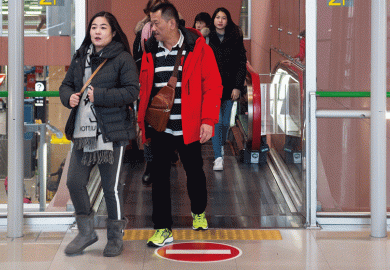Japan’s long-running problems in attracting international research talent could be addressed with more competitive and flexible funding models, a sector leader has said.
Peter Gruss, president of the Okinawa Institute of Science and Technology Graduate University (OIST), told the Times Higher Education Asia Universities Summit that Japan should take inspiration from the European Research Council, which offers long-term funding to the best academics both at the start of their careers and when they are well established.
“You fund people, not projects, and you give those people both independence and security over a five-year period,” Professor Gruss said, adding that this is how OIST funds its own researchers.
Professor Gruss has led OIST since 2017 and, before then, spent 12 years as president of Germany’s Max Planck Society, which provides funding to its researchers for seven-year windows.
Professor Gruss said that research systems whose funding relied heavily on short-term competitive grants tended to be less competitive overall. “High-trust funding can lead to high-risk, creative research,” he said.
Professor Gruss has a unique challenge at OIST, a postgraduate institution offering five-year doctorates in a fully multidisciplinary structure that has “no departments”.
It was established just a decade ago on an island more than 1,800km from Tokyo, which makes recruitment “not an easy task”. Despite this challenge, OIST is unusually highly internationalised, with 65 per cent of professors and 80 per cent of students coming from outside the country.
“We wanted to try something entirely different,” Professor Gruss said. “We want to be a catalyst for innovation in Okinawa.”
He saw this progression in Europe, where governments started pouring funding into research institutions in the 1960s and 1970s. “Now, 50 or 60 years later, these institutions are the nucleus for new towns, businesses and opportunities,” he said.
A factor in OIST’s success has been its use of English in teaching and research, the low uptake of which has been seen as a brake on other Japanese universities’ attempts to recruit international staff and students.
“Japan is not doing so well in terms of the internationalisation of universities,” Professor Gruss admitted. “It’s a challenge to recruit and retain top science and technology talent from around the globe, including Japanese returnees.”
He cited other well-known reasons for this problem, such as salary packages that “do not meet expectation” and a “conservative” HE structure.
“There is a need for university reform that emphasises that international component,” he said.
East Asian countries such as China and South Korea are investing heavily in research, and Japan is no exception.
Tokyo announced this year that it would raise ¥10 trillion (£70 billion) in capital for a “university fund” to be managed by the Japan Science and Technology Agency. However, there are few details on how that funding will be allocated.
“They are still discussing how to bring in new means and mechanisms to address deficiencies in the system,” Professor Gruss said.
Register to continue
Why register?
- Registration is free and only takes a moment
- Once registered, you can read 3 articles a month
- Sign up for our newsletter
Subscribe
Or subscribe for unlimited access to:
- Unlimited access to news, views, insights & reviews
- Digital editions
- Digital access to THE’s university and college rankings analysis
Already registered or a current subscriber?








